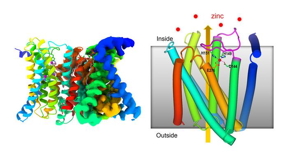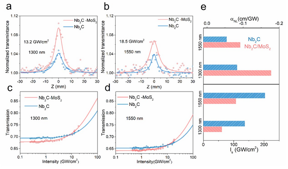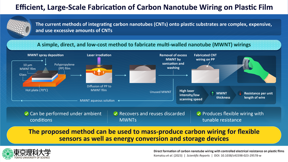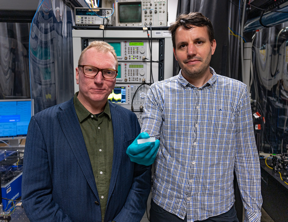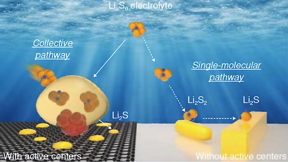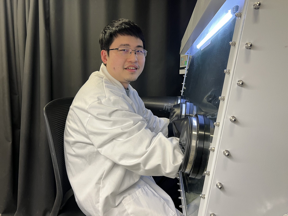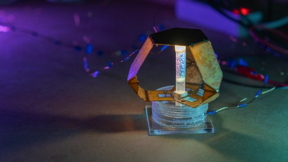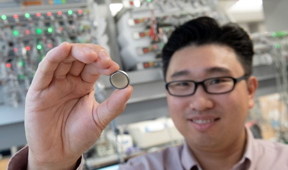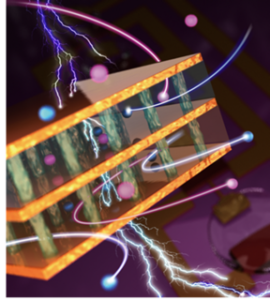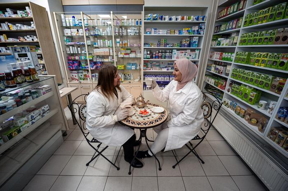Home > Press > Simple ballpoint pen can write custom LEDs
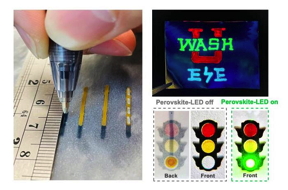 |
| Junyi Zhao in the McKelvey School of Engineering demonstrates using a simple ballpoint pen to write custom LEDs on paper (left). The same pens can be used to draw multicolored designs on aluminum foil (top right) and to create light up sketches (bottom right). CREDIT Courtesy of Wang lab, Washington University in St. Louis |
Abstract:
Researchers working with Chuan Wang, an associate professor of electrical and systems engineering at the McKelvey School of Engineering at Washington University in St. Louis, have developed ink pens that allow individuals to handwrite flexible, stretchable optoelectronic devices on everyday materials including paper, textiles, rubber, plastics and 3D objects.
Simple ballpoint pen can write custom LEDs
St. Louis, MO | Posted on August 11th, 2023
In a paper published Aug. 7 in Nature Photonics, the team reports their simple and versatile fabrication approach to allow anyone to make a custom light-emitting diode (LED) or photodetector without the need for any specialized training or bulky equipment. The new handheld fabrication technology builds on earlier work by Wang and first author Junyi Zhao, a doctoral candidate in Wang’s lab, in which they demonstrated a novel way to fabricate stretchable LEDs with an inkjet printer.
“Handwriting custom devices was a clear next step after the printer,” Wang said. “We had the inks already, so it was a natural transition to take the technology we had already developed and modify it to work in regular ballpoint pens where it could be cheap and accessible to all.”
Read more on the McKelvey School of Engineering website.
####
For more information, please click here
Contacts:
Talia Ogliore
Washington University in St. Louis
Office: 314-935-2919
Copyright © Washington University in St. Louis
If you have a comment, please Contact us.
Issuers of news releases, not 7th Wave, Inc. or Nanotechnology Now, are solely responsible for the accuracy of the content.
| Related Links |
| Related News Press |
News and information
![]() Femtosecond laser technique births “dancing microrobots”: USTC’s breakthrough in multi-material microfabrication August 11th, 2023
Femtosecond laser technique births “dancing microrobots”: USTC’s breakthrough in multi-material microfabrication August 11th, 2023
![]() USTC achieved dynamic imaging of interfacial electrochemistry August 11th, 2023
USTC achieved dynamic imaging of interfacial electrochemistry August 11th, 2023
![]() Chloride ions from seawater eyed as possible lithium replacement in batteries of the future August 11th, 2023
Chloride ions from seawater eyed as possible lithium replacement in batteries of the future August 11th, 2023
Display technology/LEDs/SS Lighting/OLEDs
![]() Novel design perovskite electrochemical cell for light-emission and light-detection May 12th, 2023
Novel design perovskite electrochemical cell for light-emission and light-detection May 12th, 2023
![]() A universal HCl-assistant powder-to-powder strategy for preparing lead-free perovskites March 24th, 2023
A universal HCl-assistant powder-to-powder strategy for preparing lead-free perovskites March 24th, 2023
![]() 3D-printed decoder, AI-enabled image compression could enable higher-res displays December 9th, 2022
3D-printed decoder, AI-enabled image compression could enable higher-res displays December 9th, 2022
![]() Liquid crystal templated chiral nanomaterials October 14th, 2022
Liquid crystal templated chiral nanomaterials October 14th, 2022
Possible Futures
![]() USTC achieved dynamic imaging of interfacial electrochemistry August 11th, 2023
USTC achieved dynamic imaging of interfacial electrochemistry August 11th, 2023
![]() Chloride ions from seawater eyed as possible lithium replacement in batteries of the future August 11th, 2023
Chloride ions from seawater eyed as possible lithium replacement in batteries of the future August 11th, 2023
![]() Tattoo technique transfers gold nanopatterns onto live cells August 11th, 2023
Tattoo technique transfers gold nanopatterns onto live cells August 11th, 2023
Discoveries
![]() Chloride ions from seawater eyed as possible lithium replacement in batteries of the future August 11th, 2023
Chloride ions from seawater eyed as possible lithium replacement in batteries of the future August 11th, 2023
![]() Tattoo technique transfers gold nanopatterns onto live cells August 11th, 2023
Tattoo technique transfers gold nanopatterns onto live cells August 11th, 2023
Announcements
![]() Chloride ions from seawater eyed as possible lithium replacement in batteries of the future August 11th, 2023
Chloride ions from seawater eyed as possible lithium replacement in batteries of the future August 11th, 2023
![]() Tattoo technique transfers gold nanopatterns onto live cells August 11th, 2023
Tattoo technique transfers gold nanopatterns onto live cells August 11th, 2023
Interviews/Book Reviews/Essays/Reports/Podcasts/Journals/White papers/Posters
![]() Chloride ions from seawater eyed as possible lithium replacement in batteries of the future August 11th, 2023
Chloride ions from seawater eyed as possible lithium replacement in batteries of the future August 11th, 2023
![]() Tattoo technique transfers gold nanopatterns onto live cells August 11th, 2023
Tattoo technique transfers gold nanopatterns onto live cells August 11th, 2023
Printing/Lithography/Inkjet/Inks/Bio-printing/Dyes
![]() Disposable electronics on a simple sheet of paper October 7th, 2022
Disposable electronics on a simple sheet of paper October 7th, 2022
![]() On-Chip Photodetection: Two-dimensional material heterojunctions hetero-integration May 13th, 2022
On-Chip Photodetection: Two-dimensional material heterojunctions hetero-integration May 13th, 2022
- SEO Powered Content & PR Distribution. Get Amplified Today.
- PlatoData.Network Vertical Generative Ai. Empower Yourself. Access Here.
- PlatoAiStream. Web3 Intelligence. Knowledge Amplified. Access Here.
- PlatoESG. Automotive / EVs, Carbon, CleanTech, Energy, Environment, Solar, Waste Management. Access Here.
- PlatoHealth. Biotech and Clinical Trials Intelligence. Access Here.
- ChartPrime. Elevate your Trading Game with ChartPrime. Access Here.
- BlockOffsets. Modernizing Environmental Offset Ownership. Access Here.
- Source: http://www.nanotech-now.com/news.cgi?story_id=57379
- :not
- :where
- $UP
- 10
- 10th
- 28
- 2D
- 3d
- 6th
- 7
- 7th
- 9th
- a
- accessible
- accuracy
- Achieve
- achieved
- After
- All
- allow
- already
- an
- and
- any
- anyone
- Application
- approach
- ARE
- AS
- Associate
- At
- Aug
- AUGUST
- author
- batteries
- BE
- Better
- Bottom
- breakthrough
- builds
- by
- CAN
- candidate
- cell
- Center
- CGI
- cheap
- clear
- click
- color
- Columbia
- COM
- comment
- content
- Conversion
- could
- create
- created
- credit
- Crystal
- custom
- Dancing
- December
- demonstrated
- demonstrates
- Design
- designers
- designs
- developed
- Devices
- discover
- DOT
- draw
- dynamic
- Earlier
- Electronic
- Electronics
- enable
- end
- Engineering
- equipment
- Ether (ETH)
- evaluation
- everyday
- Expand
- First
- flexible
- foil
- For
- from
- gif
- Gold
- Graphene
- had
- Have
- http
- HTTPS
- if
- image
- Imaging
- improve
- in
- Inc.
- Including
- individuals
- information
- IT
- jpg
- june
- lab
- laser
- layered
- Led
- left
- light
- links
- lithium
- live
- Louis
- make
- March
- material
- materials
- Matter
- May..
- modify
- more
- nanotechnology
- Natural
- Nature
- Need
- net
- New
- news
- next
- Noise
- novel
- now
- objects
- october
- of
- Offers
- on
- or
- out
- Paper
- patterns
- performance
- PHP
- plastics
- plato
- Plato Data Intelligence
- PlatoData
- please
- possible
- Post
- posted
- potential
- preparing
- press
- Press Release
- Product
- Professor
- prototypes
- published
- Push
- Quantum
- Quantum dot
- Quantum dots
- random
- regular
- release
- Releases
- replacement
- Reports
- researchers
- responsible
- Results
- return
- right
- rubber
- s
- Said
- same
- Save
- School
- School of Engineering
- Search
- Semiconductors
- Share
- sheet
- Simple
- So
- solely
- specialized
- start
- Step
- Strategy
- submit
- system
- Systems
- Take
- team
- Technology
- textiles
- that
- The
- their
- they
- this
- to
- top
- Training
- transfers
- transition
- twist
- Universal
- university
- unwanted
- us
- used
- using
- USTC
- versatile
- Voltage
- was
- washington
- Wave
- Way..
- we
- Website
- which
- with
- without
- Work
- working
- write
- Yahoo
- you
- zephyrnet
- Zhao










